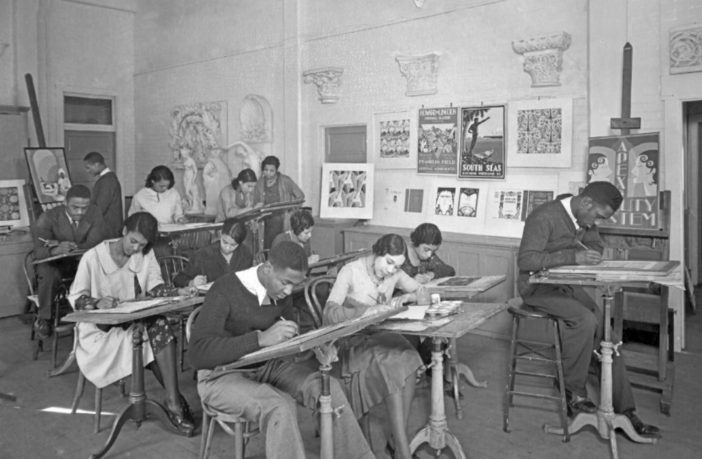By Michayla Maxwell,
Special to the AFRO
Just weeks into the new year, the Anacostia Community Museum is ready to celebrate the opening of its new 2024 exhibition.
The Anacostia Community Museum will be opening “A Bold and Beautiful Vision: A Century of Black Arts Education in Washington D.C.,1900-2000” on March 23. This exhibit will run through the spring of 2025 and celebrates some of Washington, D.C.’s most gifted artists.
Samir Meghelli is the curator of “A Bold and Beautiful Vision” and hopes to tell the story of the teachers and students who made Washington, D.C., a genuinely unparalleled center for Black arts education. He was able to feature both known and not so well known artists including Elizabeth Catlett, Alma Thomas, James A. Porter, Loïs Mailou Jones, David Driskell, Hilda Wilkinson Brown, Sam Gilliam, Thomas Hunster and Georgette Seabrooke Powell.
“Rarely has it been acknowledged that some of the twentieth century’s most gifted artists taught and were educated in Washington, D.C. schools. The city is home to a long line of African American artist-educators who dedicated their lives to inspiring a love of the arts in young people despite the challenges of a longtime segregated, underfunded education system,” Meghelli said.
Meghelli sees this year’s exhibit as an opportunity to share “rich history” and “international mentorship” with the rest of the D.C. community. The exhibit will include a wide array of arts and artifacts that can showcase the “little-known, but rich history” of black artist educators.
Included in the showcase are original prints from Elizabeth Catlett’s first-ever solo exhibit which was previously at D.C.’s own Barnett-Aden Gallery, one of the first Black-owned commercial art galleries in the nation. They were a fixture for many years at her alma mater, D.C.’s Dunbar High School. The exhibit will also include a painting Sam Gilliam made while he was a teacher at McKinley Tech High School in the 1960s, a marionette that William Buckner made with his Armstrong High School students in the late 1930s, and silkscreen concert posters that Lou Stovall and Lloyd McNeill made in the late 1960s for the Adams Morgan-based youth arts organization.
Due to so much artistic history in D.C., one of the biggest challenges Meghelli faced was choosing what pieces to include.
“The exhibition covers over a century of history and the stories of inimitable artists and educational institutions. Knowing we have the limitations of time and space, we hope that this exhibition will open up space for more and future exhibitions that explore the topics and which can include the work and stories of even more artists,” Meghelli said.
“We began conceptualizing the exhibition by diving into our museum’s archives and art collection, which contain incredible stories of local Black Washington arts communities dating back to our museum’s founding in 1967 and even much further back than that,” he said.
“Inspired by the deeply-rooted and intergenerational relationships among artist educators and their students over so many years, we set out to begin telling the story of that lineage—almost a family tree, in a way—of Washington’s African American art teachers and their influence across the generations.”
Meghelli was able to break down the exhibition into four major sections, which include different hands-on art activities, artwork, artifacts, photographs and videos to create the theme throughout the exhibit.
The exhibition starts by tracing the rise of art education in Washington’s segregated public school system in the late 19th and early 20th century and the pioneering work of educators at the city’s first two high schools for Black students: M Street High School (later known as Dunbar High) and Armstrong Manual Training School.
Next comes the work reflecting Howard University’s Art Department and its faculty and distinguished alumni.
The third section examines the impact of school desegregation and the rise of Black power on arts education in Washington.
The final section features the story of Duke Ellington School of the Arts, which Peggy Cooper Cafritz and Mike Malone began as a small program called Workshops for Careers in the Arts in the late 1960s but which has grown into a prestigious pre-professional arts school that has now graduated generations of talented artists of all disciplines.
“The exhibition includes prints, objects and art materials used by artists and teachers throughout this period,” said Shanita Brackett, acting director of the museum. Once an object that intrigues me demonstrates the lineage and connection between art teachers and students, it’s presented as a lineage or bubble map.”
She believes once someone can understand “the impact of each teacher and the artists they taught, as well as the collaboration between those artists, their genres and art forms, and their geographic base and work, then they can discover a rich history of reach and influence.”
The Anacostia Community Museum is the first federally funded community museum in the nation, United States. Brackett said she hopes, “visitors will leave the exhibition with a new appreciation for black arts education, and generations of artists, educational institutions, and communities will look back and appreciate the profound specialties and skills shared with so many others on various platforms.”
Brackett said community programming is crucial.
“We will host various community-based and family-friendly programs,” she said, “including Earth Day on April 20, which will also be the launch of our Farm Stand for the season, and Juneteenth on June 19, which will showcase local artists and musicians.”



